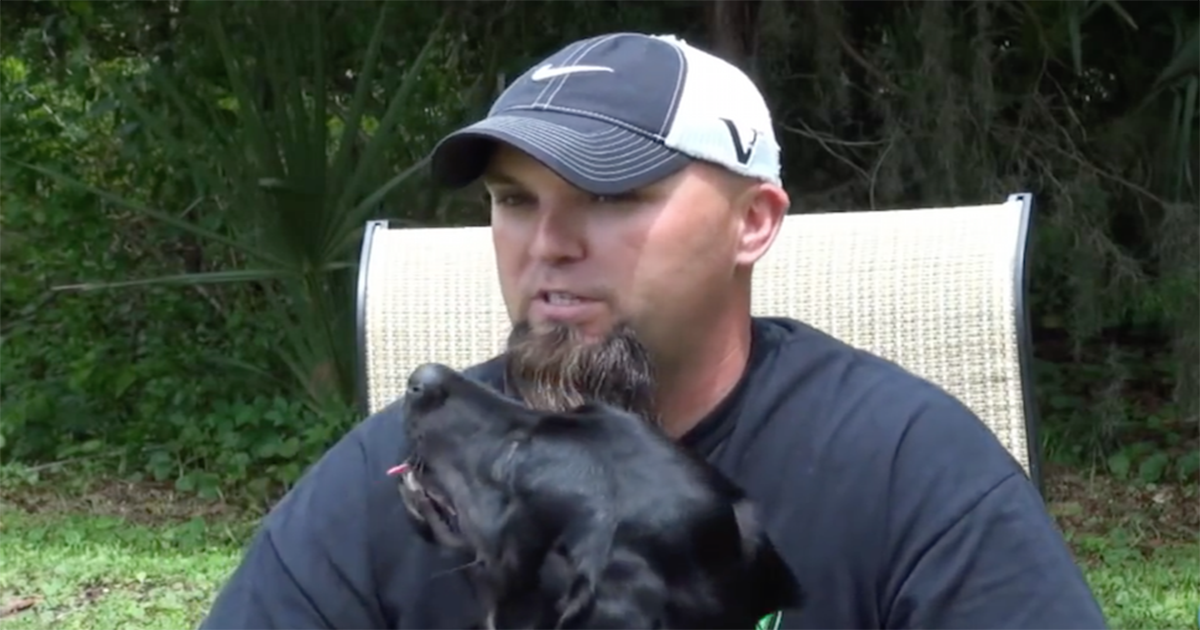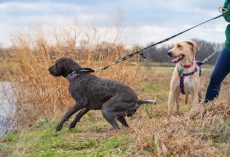Erick Scott, a veteran who served in Iraq, knows first-hand what it’s like to suffer from PTSD (Post-traumatic stress disorder – a mental health condition triggered by experiencing or seeing a terrifying event).
PTSD is also sometimes known as shell shock or combat stress, occurs after experiencing severe trauma or a life-threatening event.
For all too many veterans, it's hard to readjust to life out of the military or getting haunted by unpleasant memories and experiences. Erick was no exception.
To help him combat his anxiety, he was paired with a special service dog, Gumbo. Gumbo's main role was to notify him when he started showing symptoms of PTSD.
Watch the video on the next page to see Gumbo's amazing reaction when Scott gets agitated on camera during an interview. This is incredibly touching to see.












Meghan Thomas
- Edit
I am a PTSD therapist for the VA, specializing in combat and sexual trauma. It is amazing how much dogs can aid in recovery. My own dog is a therapy dog himself
Meghan Thomas
- Edit
I am a PTSD therapist for the VA specialized in combat and sexual trauma. PTSD has physical symptoms but that does not negate the mental or cognitive disorder. PTSD is the inability to mentally recover after a traumatic event.
Ann Isler-Korbaj
- Edit
Paul Heath I also own a Rottweiler he’ll be 9 on the 15th of this month. I have had PTSD since I was in my twenties and I am now 50 years old as of May 13th. He was the best decision in my life that I ever made besides having my children. My dog comes to me whenever he hears me cry or in pain. He totally knows my emotions. The day I met him we were in a circle 5 people and he was running around and came running right up to me. so, I picked him up I looked him right in the eyes and I asked him do you promise to love honor obey and protect me at all times till death do us part. everybody couldn’t believe what happened next including myself he just licked my whole face as if you knew exactly what I just asked him. He is not let me down ever since and that was when he was 4 months old. I love my German Rottweiler.
Kalli Shannon
- Edit
Donelle Marquiss
Lorraine Chay
- Edit
Went around and around in circles and never did see the video. Nothing would play. Oh well.
Eric Angela Brooks
- Edit
Amazing
Donald Freeman
- Edit
Pinch collars are a great tool.
Vickie Baggett
- Edit
I need one for my son and his pstd
Sue Mitchell
- Edit
Amazing !
Daniel Jason Paul
- Edit
I have a good friend with a service dog and it makes a world of difference.
RJ Sumsum
- Edit
LD Trueman
Elizabeth Callaghan Mullaney
- Edit
K9 Warriors for Military Hero’s.❤️
Janice Green
- Edit
that was amazing dogs are just fantastic
James Smith
- Edit
Jeremiah you probably already know about this
Chad Norpel
- Edit
Robert James
Tina Storms Tiller
- Edit
AMEN
Joanne Duggins
- Edit
I know what you mean. I have to take medication to stop mine x
Joanne Duggins
- Edit
I’ve been a sufferer for nearly 30 years x
Mike Matey
- Edit
Dogs are amazing animals
Alissa Lopez
- Edit
Oh okay. Well prong collars offer assistance. Whether it be for the owner, trainer, or the dog. Now be it for the trainer, let’s say the dog has a command. For an alert say he feels the anxiety coming on but the dog is over there sniffing the flowers. The owner would place the command, “Bowie (offer a second to catch themselves if not place the correction) come” . Now most dogs DO NOT FEEL LEASH CORRECTIONS. All these people down here “oh my god, prong collars, noo”. Now I can personally attest for the fact that my dog does not even feel shock collars let alone a damn prong collar. These collars don’t just stab dogs because they’re on. Which is what a lot of people fail to realize.
Alissa Lopez
- Edit
Celena Lucero
Ariel Rachel
- Edit
Sarah Elizabeth Pietryka
Sarah Elizabeth Pietryka
- Edit
That is so amazing
Amanda Jett Freeman
- Edit
I love labs and this is such a great program. Bless everyone who is involved in this program.
Richard Mccue
- Edit
Jack Povey check this out
Marg Vernall-Rushton
- Edit
Given what he gets from the dog what a great way to pay it back making it wear a prong collar – git!
Kelly Kiger
- Edit
I wish you blessings and thank you for your service. God bless you.
Robert James
- Edit
Soon chad I’ll have mine
Anna Skaff
- Edit
Agree. Soon that dog may need rehab for PTSD too after the use of that collar.
Judy Dickens Stanley
- Edit
I hate prong collars …they r inhumane..pinch and stab the dog..they should ne outlawed..
Judy Dickens Stanley
- Edit
It is a simply an easy way to make a dog do whatever u want …hate them..
Mirena F'kkn Miljkovic
- Edit
Alex J Merino
Carol Morton
- Edit
They bring you back to the moment that is now, not what happened.
Jordan David
- Edit
Pong collars actually mimic natural mom picking the pup up its not cruel
Moy Anderson
- Edit
Omg I’ve got a frenchi ohhh ohh he’s had a stroke
Iona Rottie Mitchell
- Edit
Don’t give toss what you think of them…..I think they shouldn’t be used!!! Forced to do training…..great thing!
Pat Carkoski
- Edit
If you have never tried to keep a large, strong dog under control, then don’t condemn a prong collar!!
My guys wear them. And at 120 lbs each, the prongs allow me to walk them together. Seeing as I have significant arthritis that is wonderful. And 99% of the time the prongs sit loosely on their neck.
I used to think people who used them didn’t know how to train. Now I realize how wrong I was.
Iona Rottie Mitchell
- Edit
I have 2 Rottweilers…..I wouldn’t dream of using them
Iona Rottie Mitchell
- Edit
I use dogmatics and can walk both my 2 no problems what so ever so yeah I still think they are cruel
Anthony Kelly
- Edit
I have a rottweiler and a German Shepherd and I don’t use them
Hugo de Vries
- Edit
Kerry McGurk
Tawnia Freeman
- Edit
God Bless them both for their Services, Amen
Branden Mathew
- Edit
Iona Rottie Mitchell bring your negativity elsewhere.
Nathaniel Addley
- Edit
Julie Green Thesier at first glance I thought this was your brother. Doppelganger anyone lol. Then I read the post lol
Anthony Abdo
- Edit
This a wonderful story!
Neely Crabtree
- Edit
Dogs are so amazing and too many service Personnel left to suffer
Colleen Opaski
- Edit
May God Bless them all, being sent to serve and fight, which I personally, am against
Sue Weatherholtz
- Edit
Sad that this young man has to go through this, but very happy he has Gumbo to help him.
KimMarie Pozar Gaye
- Edit
The post at the end brought me to tears. But this is a wonderful way to deal with this without the drugs.
Diana Wooder
- Edit
These dogs are amazing !!! But was that one of those awful collars that dig into their necks it was wearing ? No dog should have that , but on a service dog ??????????